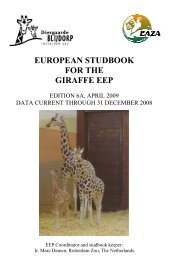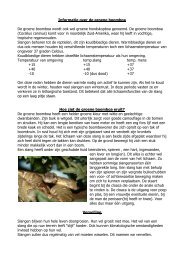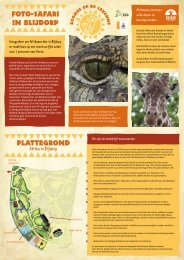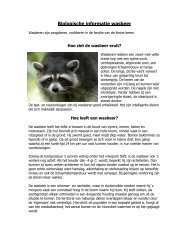You also want an ePaper? Increase the reach of your titles
YUMPU automatically turns print PDFs into web optimized ePapers that Google loves.
<strong>EEP</strong> STUDBOOK CROWNED PIGEONS PROLOGUE<br />
Prologue<br />
In the year 1598 AD, Portuguese sailors landing on the shores of the island of Mauritius<br />
discovered a previously unknown species of bird, the Dodo. Having been isolated by its<br />
island location from contact with humanity, the dodo greeted the new visitors with a childlike<br />
innocence. The sailors mistook the gentle spirit of the dodo, and its lack of fear of the<br />
new predators, as stupidity. They dubbed the bird ‘dodo’ (meaning something similar to a<br />
simpleton in the Portuguese tongue). Many dodos were killed by the human visitors, and<br />
those that survived man had to face the introduced animals. Dogs and pigs soon became<br />
feral when introduced to the Mauritian ecosystem. By the year 1681, the last dodo had died,<br />
and the world was left worse with its passing.<br />
In 1627 Mauritius was visited by an English adventurer, Thomas Herbert. The island was<br />
uninhabited by man, but there were a considerable <strong>number</strong> of weird looking, flightless birds,<br />
possessing what Herbert describes as ‘a melancholic look’. James Greenway in “Extinct and<br />
Vanishing Birds of the World” describes the dodo in these terms:<br />
“A large and heavily built bird, the Dodo is thought to have weighed fifty pounds. Its plumage<br />
was loose and wispy, more like the down of a chick than feathers, and was grey on the body,<br />
whitish on the belly and dark on the thighs. Its huge hooked bill was grey at the base and<br />
yellowish at the tip. Its tail is depicted as a clump of wispy white feathers positioned rather<br />
high on the back. The yellowish wings are generally shown hanging rather loosely at the side,<br />
quite inadequate for flight, they may have been used in fights with rivals. The Dodo’s very<br />
large yellow feet had black claws”.<br />
The Dodo (Raphus cucullatus) did not survive long after the first settlement of the Dutch in<br />
Mauritius in 1638.Even though they described the bird as ‘walgvogel’ meaning ‘disgusting to<br />
eat’ they certainly must have had fun clobbering the clumsy creatures that waddled up to<br />
them only to be hit on the head with a stout staff. In fact the name Dodo comes from the Dutch<br />
‘Dodars’ or ‘Dodoor’, meaning a sluggard or a stupid fool.<br />
The extinction of the dodo, however, was probably due mainly to dogs, hogs and monkeys<br />
which were introduced in to the island, and they had a particular weakness for the large,<br />
single egg that the dodo laid. By 1681, the dodo had been totally wiped out. Thus it became<br />
the first creature known to have become extinct due to the actions of man and other<br />
predators, and the destruction of its habitat. Almost everything we know about the superficial<br />
anatomy of this unique bird stems from a single picture, possibly painted from a live model,<br />
by the noted fifteenth century animal painter, Roland Savery.<br />
There are few museum remains of the dodo. There is a foot in the British museum, a cranium<br />
in Copenhagen, and a foot and a head in Oxford. In 1866, a schoolteacher, Georg Clark,<br />
discovered a large <strong>number</strong> of bones in a swamp in the south of the island of Mauritius. In<br />
fact, in the area which now houses the airport. (Ironically, the home of the flightless bird is<br />
now the meeting place of jet aircraft). The bones George Clark found were not enough to reconstitute<br />
an entire dodo. However, a complete skeleton, made up of the remains of several<br />
individuals, is to be found at Durban Museum.<br />
3

















